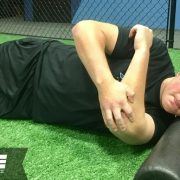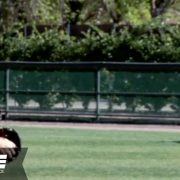The Dynamic Neuromuscular Stabilization Approach To Arm Care
Dynamic Neuromuscular Stabilization (DNS) is a method of training stability and movement of the arm and body. Not only does it help with longevity and health of the arm, but also with movement and functionality of the kinetic energy system. DNS is revolutionizing rehabilitation, and its principles can be directly applied to pitching.
The function and position of the diaphragm is foundational to DNS. Dr. Hans Lindgren’s previous article on diaphragmatic function and intra-abdominal pressure (IAP) called “Core Stability From the Inside Out” exposes the importance of this mechanism. IAP is the foundation for which the spine is stabilized and forces are efficiently transferred throughout the body.
Joint centration is the other main tenet of DNS. Joint centration is defined as the ideal loading of a joint in a neutral position that enables:
- Optimal loading
- Ideal balance between agonistic and antagonistic muscles
- Generation of maximum muscle power
Joint Centration is a position in which the joint surfaces are in maximum contact and the ligaments and capsule have low tension. In this position, all muscles around the joint can most effectively be activated. Symmetrical activation of the muscles around any joint is the hallmark of ideal function without injury. When disturbed, there can be catastrophic joint injury (ie ACL tear) or more low level chronic injuries such as: forms of tendonitis, ligament strains, and spinal disc herniation’s to name a few. DNS exercises emphasize joint centration at all times regardless of the position being used to exercise.
The concept of DNS is based on the scientific principles of developmental kinesiology. Meaning, all positions used for exercise in DNS are the same positions every human-being will advance through in the first year of life. If the baby develops normally, and the right environment is present, the correct activation of all muscles helps to form the joint surfaces and skeleton. This has enormous implications for baseball pitchers. If the development is not ideal then performance and arm health can be drastically altered later in life.
As a baby develops, they must use their body as efficiently as possible which means proper joint centration, intra-abdominal pressure, and global stabilization. There are phases for development of the stabilization function that are:
- 0 – 4.5 months (Sagittal stabilization)
- From 4.5 months (Extremity function differentiation within global patterns)
- From 8 months (Development of locomotor function)
For example, at 3 months of development in the prone position (on the stomach), the baby starts to integrate all the muscles involved in scapular stabilization. This is a complex strategy that involves many muscles, including some away from the shoulder girdle. Correct diaphragm position and IAP is a prerequisite for activation of key scapular stabilizers such as serratus anterior. Using closed chain exercises (elbow or hand support) is imperative for establishing the correct stabilization around the shoulder. This allows the muscles to be pulled from the opposite direction. Said differently, because the distal segment is now fixed (elbow) all the muscles around the shoulder reverse their direction of pull. Traditional rehabilitation exercises often neglect this function.
You can learn more about DNS and the stages of developmental kinesiology. Also, if you’re interested in taking a DNS course you can check to see if they’re coming to your area.
The function of the scapula during the throwing motion is to allow 3-dimensional movement as well as coactivation of the muscles around the scapula to allow functional stabilization throughout the ranges of motion. Dr. W Ben Kibler was one of the first to discuss scapular dyskinesis. Kibler has shown that dysfunctional scapular movement can possibly lead to injury if not addressed, which is incredibly prevalent in the overuse community of baseball. He was also one of the first people to start talking about the importance of the entire kinetic chain as it relates to arm injuries.
Most injuries in baseball are non-contact which means that injuries occur because of stress overload, which can be from repetitive overuse, poor mechanics, or both. If not a biomechanical issue, often improper stabilization of the shoulder girdle can be found in both shoulder and elbow injuries.
Kibler has shown that patients with scapular dyskinesis will demonstrate:
- Medial or inferomedial scapular border prominence (winging)
- Early scapular elevation or shrugging on arm elevation
- Rapid downward rotation on lowering of the arm
To assess scapular dyskinesis we will demonstrate a couple of DNS tests.
The 4-point rock test
Start on your hands and knees, rock back and forth several times and observe for any fatiguing or lack of stabilization in the scapula or hips.
What to look for:
- Hand support (improper support on outside of palms)
- Gradual winging of scapula
- Medial border of scapula more than 2.5 – 3 inches away from spine.
Shoulder abduction test
The shoulder abduction test is where you raise your arms from the side all the way up and bring them down in a controlled manner.
What to look for:
- Early activation of the scapula before 90 degrees of abduction
- Clunking or popping of the scapula during abduction
- Rapid downward rotation upon lowering of arm
These strategies can be used for rehabbing an injury, improving performance, and they’re a great warm up because it neurologically wakes up the muscles that hold the scapula in a good position.
Now let’s dig into a few of the exercises that really set this technique apart. We’re going to start with only a few to leave you with to master. The first exercise is called the…
5-7.5 Month Uprighting
You’ll start on your side laying on your shoulder with your arm directly out in front of you. Next, you’ll drive pressure into the ground with your elbow and bring your upper half off the ground trying not to bend too much at the torso. Slowly lower your body back down using the muscles around your scapula.
Repeat this process 8-10 reps in a situation where you’re trying to strengthen those muscles and 3-4 reps when you’re just warming up before throwing or exercises.
Bear
Start on your hands and knees just like the 4-point rock test with your hands under your shoulders and knees under your hips. Next, raise your knees about 5 to 6 inches off the ground. You’ll be supporting your weight while stabilizing at your hips and your shoulders. Now while staying as balanced as possible, lift one hand or foot (either side) off the ground 1 inch and hold it there for 15 seconds. Alternate until you run through all 4 extremities, or you can just hold the normal bear starting position. The important part is to feel the stabilization in the shoulder blades and the hips.
Again, this can be performed in a strengthening or in a warm-up setting and reps/sets should be done appropriately.
In conclusion, there are several different approaches to stabilizing the scapula. We believe a strategy that utilizes development kinesiology principles is the most effective. Many different developmental positions could be used; however, certain positions have a greater influence on the shoulder blade than others. Every exercise is a snapshot of the developmental sequence and will always be seen in the normal developing child. If the correct IAP and joint centration is maintained throughout the exercise, then the CNS will be able to proportionately activate all the muscles around the shoulder blade. Training and rehabilitation techniques that focus solely on individual muscles (ex. rotator cuff) may not create the most ideal stabilization strategy around the shoulder. These principles are revolutionizing how we assess and treat the throwing athlete.
Although this article has focused on assessment and treatment, the principles can also be used for biomechanical evaluation of the pitcher.
This article was co-written by Tyler White, co-founder of Gestalt Performance.
References:
- Kibler, Ben W., and John McMullen. “Scapular dyskinesis and its relation to shoulder pain.” Journal of the American Academy of Orthopaedic Surgeons11.2 (2003): 142-151.
- Burkhart, Stephen S., Craig D. Morgan, and W. Ben Kibler. “The disabled throwing shoulder: spectrum of pathology Part III: The SICK scapula, scapular dyskinesis, the kinetic chain, and rehabilitation.” Arthroscopy: The Journal of Arthroscopic & Related Surgery 19.6 (2003): 641-661.
- Burkhart, Stephen S., Craig D. Morgan, and W. Ben Kibler. “The disabled throwing shoulder: spectrum of pathology Part I: pathoanatomy and biomechanics.” Arthroscopy: The Journal of Arthroscopic & Related Surgery19.4 (2003): 404-420.
- Wilk, Kevin E., Leonard C. Macrina, and Michael M. Reinold. “Non-operative rehabilitation for traumatic and atraumatic glenohumeral instability.” North American journal of sports physical therapy: NAJSPT 1.1 (2006): 16.
- Frank, Clare, Alena Kobesova, and Pavel Kolar. “Dynamic neuromuscular stabilization & sports rehabilitation.” International journal of sports physical therapy 8.1 (2013): 62.
Brett Winchester
Latest posts by Brett Winchester (see all)
- The Dynamic Neuromuscular Stabilization Approach To Arm Care - December 12, 2017











Leave a Reply
Want to join the discussion?Feel free to contribute!